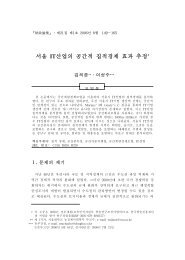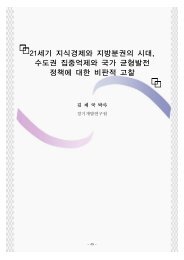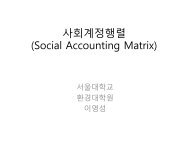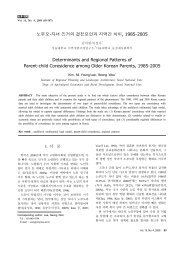무리행동과 지각된 유용성이 이러닝 컨텐츠 구매의도에 미치는 영향 ...
무리행동과 지각된 유용성이 이러닝 컨텐츠 구매의도에 미치는 영향 ...
무리행동과 지각된 유용성이 이러닝 컨텐츠 구매의도에 미치는 영향 ...
- No tags were found...
You also want an ePaper? Increase the reach of your titles
YUMPU automatically turns print PDFs into web optimized ePapers that Google loves.
<strong>무리행동과</strong> <strong>지각된</strong> <strong>유용성이</strong> <strong>이러닝</strong> <strong>컨텐츠</strong> <strong>구매의도에</strong> <strong>미치는</strong> <strong>영향</strong><br />
tions, Automation and Information Systems,<br />
IFIP, 1990.<br />
[50] Nielsen, J., Designing web usability, New<br />
Riders Publishing, Indianapolis, Indianapolis,<br />
IN, 2000.<br />
[51] Palmer, J. and Griffith, M., "An emerging<br />
model of web site design for marketing,"<br />
Communications of ACM, Vol. 41, No. 3,<br />
1998, pp. 44-51.<br />
[52] Palmer, J.W., "Web site usability, design,<br />
and performance metrics," Information Systems<br />
Research, Vol. 13, No. 2, 2002, pp. 151<br />
-167.<br />
[53] Park, C., "Discriminating factors of cyber<br />
shoppers in Korea: focused on computer<br />
-mediated communication and perceived<br />
risk of cyber shopping," Quarterly Journal of<br />
Electronic Commerce, Vol. 2, No. 2, 2001, pp.<br />
147-155.<br />
[54] Petty, R.E. and Cacioppo, J.T. "The elaboration<br />
likelihood model of persuasion,"<br />
Advances in Experimental Social Psychology,<br />
Vol. 19, 1986, pp. 123-205.<br />
[55] Petty, R.E., Haugtvedt, C.P., and Smith, S.<br />
M., Elaboration as a determinant of attitude<br />
strength: Creating attitudes that are<br />
persistent, resistant, and predictive of behavior.<br />
In R.E. Petty, and J.A. Krosnick<br />
(Eds.), Attitude strength: Antecedents and<br />
consequences (pp. 93-130), Mahwah, NJ:<br />
Lawrence Erlbaum Associates, 1995.<br />
[56] Rose, G., Khoo, H., and Straub, D., "Current<br />
technological impediments to business-to-consumer<br />
electronic commerce,"<br />
Communications of the Association for Information<br />
Systems, Vol. 1, No. 1, 1999, pp. 1<br />
-74.<br />
[57] Shapiro, C. and Varian, H., Information<br />
rules, Harvard Business School Press, Boston,<br />
MA, 1999.<br />
[58] Shneiderman, B., "Designing the user interface:<br />
strategies for effective humancomputer<br />
nteraction," Addison-Wesley, MA,<br />
1998.<br />
[59] Tan, S.J., "Strategics for reducing consumer’s<br />
risk aversion in internet shopping,"<br />
Journal of Consumer Marketing, Vol. 16, No.<br />
2, pp. 163-180.<br />
[60] Taylor, S. and Todd, P.A., "Assessing IT<br />
usage: the role of prior experience," MIS<br />
Quarterly, Vol. 19, No. 4, 1995, pp. 561-570.<br />
[61] Tsakonas, G. and Papatheodorou, C., "Analysing<br />
and evaluating usefulness and usability<br />
in electronic information services,"<br />
Journal of Information Science, Vol. 32, No. 5,<br />
2006, pp. 400-419.<br />
[62] Tyler, K., "Take the e-learning to the next<br />
step: e-learning programs move beyond<br />
online catalogs to individual assessments<br />
and professional development plans-focus<br />
on training and development," HR Magazine,<br />
2002.<br />
[63] Venkatesh, V. and Davis, F.D., "A theoretical<br />
extension of the technology acceptance<br />
model: four longitudinal field studies," Management<br />
Science, Vol. 46, No. 2, 2000, pp.<br />
186-204.<br />
[64] Werts, C.E., Lin, R.L., and Jöreskog, K.G.,<br />
"Intraclass reliability estimates: testing structural<br />
assumptions," Educational and Psychological<br />
Measurement, Vol. 34, No. 1, 1974,<br />
pp. 25-33.<br />
[65] Zhang, D., Zhao, J.L., and Nunamaker, J.<br />
F., "Can e-learning replace classroom learning?"<br />
Communication of the ACM, Vol. 47,<br />
No. 5, 2004, pp. 75-81.<br />
128 경영정보학연구 제18권 제4호
















